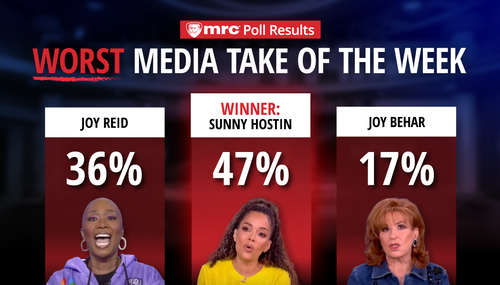Politico's magazine published an article with a surprising title: “The Media Bubble Is Worse Than You Think.” Jack Shafer and Tucker Doherty began with the 2016 election results, which was “not just as an embarrassment for the press but as an indictment. In some profound way, the election made clear, the national media just doesn’t get the nation it purportedly covers.”
The writers know they are working for a liberal media outlet with mostly liberal readers, so they unconvincingly tut-tut the notion that the media favored Hillary in their coverage. “No news organization ignored the Clinton emails story, and everybody feasted on the damaging John Podesta email cache that WikiLeaks served up buffet-style. Practically speaking, you’re not pushing Clinton to victory if you’re pantsing her and her party to voters almost daily.”
Come on. There wasn't "feasting" on Hillary scandals or "pantsing" the candidate. You're not "pantsing" Hillary when you proclaim she's the most qualified candidate since John Quincy Adams....
Their argument wasn’t about content, but about a growing demographic gap. “Concentrated heavily along the coasts, the bubble is both geographic and political. If you’re a working journalist, odds aren’t just that you work in a pro-Clinton county—odds are that you reside in one of the nation’s most pro-Clinton counties. And you’ve got company: If you’re a typical reader of Politico, chances are you’re a citizen of Bubbleville, too.” (Italics theirs.)
This is how Shafer and Doherty set the scene. Daily and weekly newspaper publishers employed about 455,000 reporters, clerks, salespeople, and designers et cetera in 1990, according to the Bureau of Labor Statistics. By January 2017, that workforce shrunk more than 60 percent to 173,900. Those losses happened all over the country.
Meanwhile, from January 2008 to January 2017, internet publishing has grown from 77,900 jobs to 206,700. In late 2015, for the first time, the number of workers in internet publishing exceeded the number of newspaper employees. Internet publishers are now adding workers at nearly twice the rate newspaper publishers are cutting them.
This, they write, is a “radical” shift in sociopolitics. "Today, 73 percent of all internet publishing jobs are concentrated in either the Boston-New York-Washington-Richmond corridor or the West Coast crescent that runs from Seattle to San Diego to Phoenix."
Newspapers used to require their reporters to live in the same communities as their readers, which is no longer true. Now, the business reporters are mostly in Manhattan. The entertainment and cultural reporters are in New York and Hollywood. National political reporting is heavily concentrated in Washington, and a sympathetic press corps has “grown apace with the federal government.” As early as the 1970s, conservatives were warning of a “new class” that included journalists that reinforced the government’s natural tendency to expand its power and budget.
Shafer and Doherty concluded:
Nearly 90 percent of all internet publishing employees work in a county where Clinton won, and 75 percent of them work in a county that she won by more than 30 percentage points. When you add in the shrinking number of newspaper jobs, 72 percent of all internet publishing or newspaper employees work in a county that Clinton won. By this measure, of course, Clinton was the national media’s candidate.
Resist—if you can—the conservative reflex to absorb this data and conclude that the media deliberately twists the news in favor of Democrats. Instead, take it the way a social scientist would take it: The people who report, edit, produce and publish news can’t help being affected—deeply affected—by the environment around them.
Shafer and Doherty expressed a hopeful note about curing “journalistic myopia,” that journalists will learn from 2016. “Journalists respond to their failings best when their vanity is punctured with proof that they blew a story that was right in front of them. If the burning humiliation of missing the biggest political story in a generation won’t change newsrooms, nothing will.”
Is there any evidence of a media realignment?
As a matter of fact, Politico just hired a new publisher named Patrick Steel. They tout he knows “how can we grow a publication that has more impact in more places with more products.” What kind of impact? A quick look at Steel’s federal campaign contributions show he’s shelled out more than $50,000 to Democrats (zero to Republicans) since 1996 – and $250 to Sen. Angus King, an independent who caucuses with the Democrats and announced he voted for Hillary Clinton for president. Last year, he threw $10,000 at Hillary Clinton and the DNC combined.
That matches his career before 16 years in Washington investment banking. For eight years, he worked for Bill Clinton’s administration, in the Agriculture and Education departments and on the White House staff.
Politico ought to know very well about how the liberal bubble is hardening. It’s hardening around their own “news” room.




